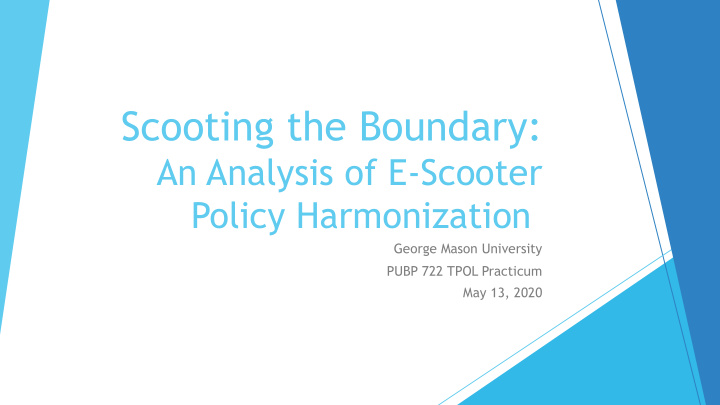



Scooting the Boundary: An Analysis of E-Scooter Policy Harmonization George Mason University PUBP 722 TPOL Practicum May 13, 2020
Team Introduction Project Context Methodology Agenda Analysis Findings Recommendations
Aleksandr Grinshpun – MA, TPOL Houda Ali – MA, TPOL Team Ellie Larson McCurdy – MA, TPOL Introduction Jephthah Nti – MA, TPOL Sid Rayaprolu – PhD, Civil and Infrastructure Engineering Sterling Wiggins – MPA and MA, TPOL
Project Context u E-scooters as shared mobility devices (SMDs) u Research question u Policy development: Pilot or Permanent u Policy harmonization u Benefits u Challenges u Feasibility u COVID-19 update
Methodology u Data collection u Preliminary analysis of permit statutes from 22 cities across the U.S. u Literature review u Peer-reviewed articles u White-papers u Popular media and blogosphere u Personal interviews and brief conversations with u Federal/state/regional/local regulatory body members u Public and private planning practitioners u Third party aggregators u Transportation planning researchers u Case study selection u Urbanized areas encompassing multiple jurisdictions
Analysis: Case Study Areas Washington, DC, and Northern Virginia u Miami and Coral Gables, Florida u Boston, Brookline, Somerville, and Cambridge, Massachusetts u Minneapolis-St. Paul, Minnesota u Los Angeles and Santa Monica, California u Oakland and Berkeley, California u
Analysis: Key Elements of Permit Ordinance Device specifications u Right-of-way specifications u Safety standards u Insurance and financial liability u Data sharing and compliance u Geo-fencing requirements u Permit fee structure u Fleet specifications u Equity and environmental justice u
Analysis: Key Elements of Permit Ordinance Device specifications u Right-of-way specifications u Safety standards u Insurance and financial liability u Similar regulatory language Data sharing and compliance u between neighboring Geo-fencing requirements jurisdictions, but different u implementation Permit fee structure u Fleet specifications u Equity and environmental justice u
Analysis: Factors Influencing Policy Harmonization u Geographical context u Average trip distance and border length u Operator selection u Decision scorecards u Road rules u Unknowingly breaking rules
Analysis: Factors Influencing Policy Harmonization u Safety standards u Helmet use u Sidewalk bans u Geofencing u Fee structure
Analysis: Levels of Harmonization Federal-level governance u u Seat-belt regulation (IIHS) State-level governance u u Preemption of ride hailing service regulation Local/Regional governance u u Capital Bikeshare u Boston area dockless bikeshare
Analysis: Levels of Harmonization Local collaboration u u City of Charlottesville, University of Virginia, and Albemarle County Customized harmonization u u Centralized/Decentralized u A-la-carte/spectrum
Findings: Potential Benefits of Harmonization u Users and non-users u Consistency of information u Improved accessibility for cross-border trips u Regulatory bodies u Constant feedback loop u Service providers u Increased market size u Economies of scale u Reduced costs u Ease of operations and compliance u Others – Transit agencies, VCs, and MaaS aggregators
Findings: Potential Barriers to Harmonization u Low cross-border activity u The percentage of internal trips is higher than cross-border trips u 10 percent of trips from Arlington County to DC u Resistance to collaborative efforts u Disparate policies allow local customization u Inhibited agility to update regulations u Reduced opportunity for start-up operators
Recommendations P olicy harmonization does not need to take a stance of All-or-Nothing u u Tailored harmonization can eliminate potential barriers u Role of partnering jurisdictions u Clearly defining priorities and equity goals u Travel demand surveys & community outreach activities u Actively collaborating in operator selection u Seeking mediation from MPOs for state or federal funding u Role of Bird and other operators u Actively complying with local regulations u Build robust government relationships through consistency in service
Schar school press release Moving Forward Peer-reviewed conference presentations and journals
Thank you Questions?
Recommend
More recommend